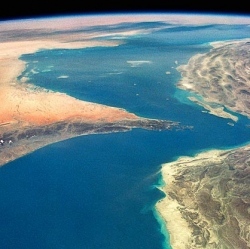
Robert Bigelow, hotel billionaire and space entrepreneur, unveiled the Bigelow Expandable Activity Module (BEAM), which will soon ship to Kennedy Space Center, stowed away in the payload of a SpaceX rocket. It will launch in September, expand, and then dock with the International Space Station. It will then serve as a test chamber for this new habitation technoogy.
Bigelow Aerospace, founded 15 years ago, is a perfect melding of his real estate and extraterrestrial interests. The company makes habitats for regions even harsher than the desert. Right now, it’s low earth orbit. But eventually, maybe even soon (fifteen years to twenty), these habitats will be on the moon, housing all sorts of corporate, science, and government types (prospectors, all). The serious money, on earth and in space, has always been in business travelers.
Right now Bigelow (the company and the man) is still very much in the proving phases. Two of the company’s modules, the Genesis I and II, have launched and inflated without incident. The BEAM is the biggest, most serious step, and the result of a $17.8 million NASA contract.
“Two and a half years ago, they were laughing at us. Not anymore,” Bigelow says, swaying slightly behind the podium. When someone asks him about if his inflatables might have use here on earth, he says that though he’s sure some folks at the company have been thinking about the “terrestrial application,” he’s “been singularly focused on the space location.”
The hangers are so large it is difficult to grasp the actual size of things. When I go in the clean room to see the BEAM,folded down, deflated, ready for transport, it is a bit of a letdown. It’s a pretty small thing. That’s the point, though. In just four and a half minutes, when it’s ready, it will expand to about 110 square meters. Two more BEAMs, this size or maybe larger, are going to be ready by 2017. The only holdup is the rockets to get it there. “Our bet is that transportation is at hand,” he tells the crowd.
With Bigelow on stage is William Gerstenmaier, NASA’s Associate Administrator for Human Exploration and Operations. Bigelow and Gerstenmaier mostly talk about what the BEAM will be doing once its docked. Namely, proving itself. Nothing like this has been part of the ISS before. It will sound different, it will retain heat differently, it will be a completely different space, it’ll be spacier, and maybe better. Maybe the astronauts will prefer it. Maybe it will turn into a kind of hangout spot.
